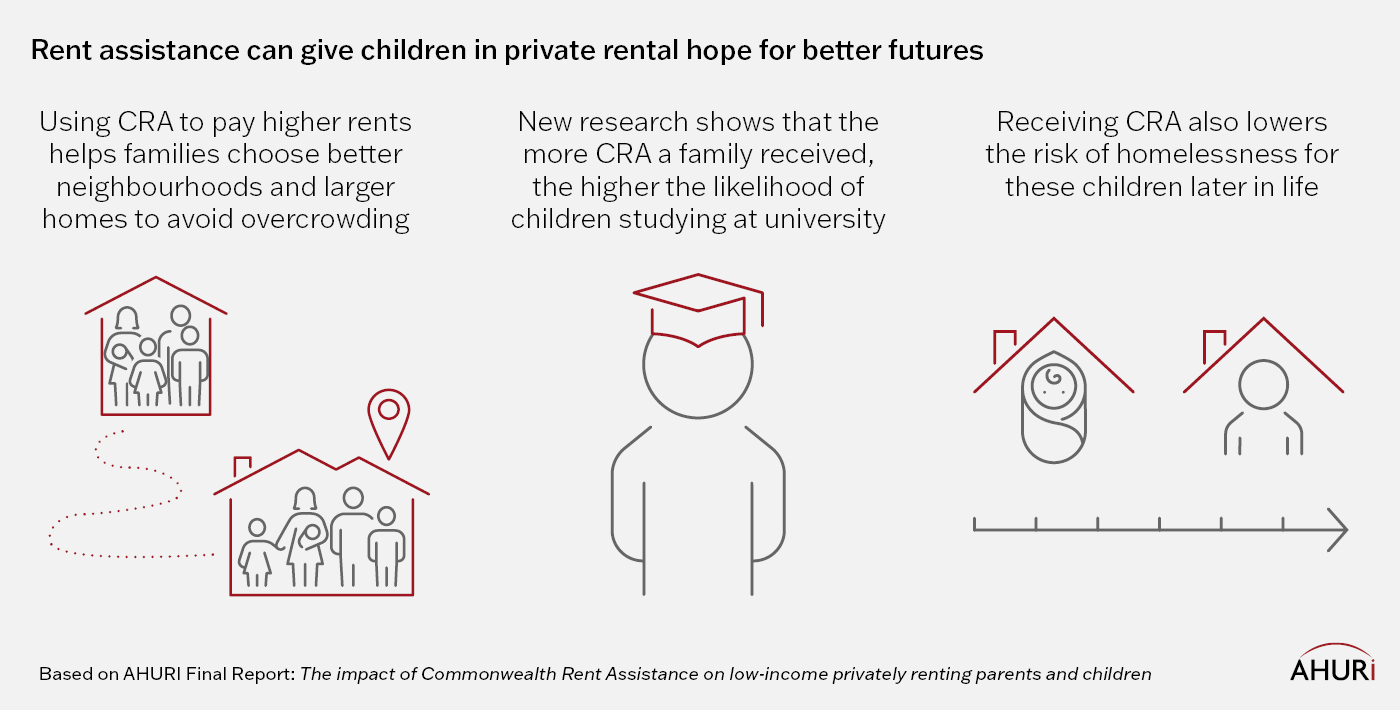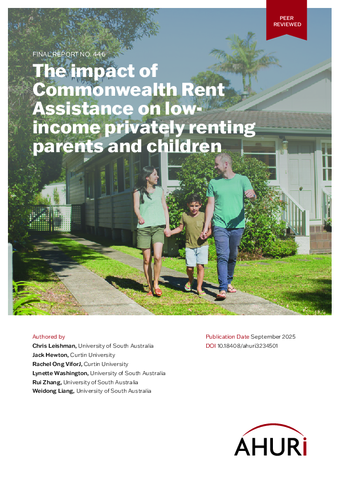What this research is about
This research looked at how Commonwealth Rent Assistance (CRA) affects low-income families who rent privately. It focused on housing, money, health and wellbeing outcomes for parents and children.
It also looks at the role of CRA in reducing disadvantage passing from parents to children. The forms of disadvantage considered in the report include poor housing, financial, wellbeing and health outcomes.
Why this research is important
CRA is Australia's biggest housing support program. It cost the federal government $5.5 billion in 2023-2024. However, there is little research on how CRA affects recipients and their children. This research helps to understand how effective CRA is at reducing disadvantage and improving wellbeing. It also shows how these effects pass to children of households that receive CRA.
-
At a glance
-
Key findings
Families who receive CRA sacrifice wellbeing to pay rent
To get CRA, a household must be low-income and eligible for a welfare payment. Families sacrifice spending on food, energy bills, health and wellbeing to keep their rental homes.
Households that receive CRA continue to suffer disadvantage, including poor educational, health, wellbeing and financial outcomes.
CRA has both maximum and minimum rent limits. Households in small homes or cheaper areas may pay rents too low to receive much CRA. For households choosing better and more expensive housing, CRA pays up to 75% of their rental costs.
Children are key beneficiaries of CRA
Around 30% of households receiving CRA have dependent children. This totals around 3 million children.
In the short term, households that receive CRA continue to experience hardship and stress. However, over the long term, the more CRA a household receives, the greater the likelihood of their children studying at university. Receiving CRA also lowers the risk of children experiencing homelessness later in life.
Families that use CRA to pay higher rents improve future outcomes for their children. The ability to pay higher rents helps families choose better neighbourhoods and larger homes to avoid overcrowding. These benefits start after families receive a certain level of CRA. This was around $70 per week at the times (2007 and 2012) when the families were living in CRA subsidised housing.
-
Policy actions
This research:
- broadens understanding of the role of CRA in housing, financial, wellbeing and health outcomes of low-income privately renting parents and children
- provides evidence of CRA’s effectiveness as a welfare-enhancing program
- offers insights into ways that CRA might be redesigned to improve the wellbeing of children as well as adults
- presents evidence of how CRA can help address intergenerational transmission of disadvantages.
Policies designed to support families with children understand the value of using CRA strategically are likely to improve outcomes. These policies can help families live in better neighbourhoods and in homes which are not overcrowded. These positive outcomes have the potential to break intergenerational patterns of housing stress, homelessness, poverty and low educational attainment, as well as negative health and wellbeing outcomes and reliance on social housing support.
CRA is set too low
Findings indicate that CRA is set too low and disadvantages smaller families. An increase in the CRA payment would increase the chance of children studying at university, and also of avoiding homelessness later in life.
-
Research design
This research analysed the Longitudinal Study of Australian Children (LSAC) survey and the Housing, Income and Labour Dynamics in Australia (HILDA) survey to understand the impact of CRA on homelessness, financial insecurity, health, wellbeing and the intergenerational transmission of disadvantage.
The LSAC started in 2003–2004 and follows a representative sample of 10,000 Australian children.



